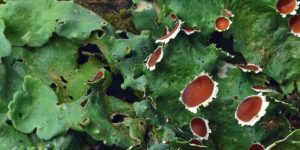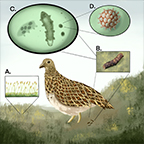
We propose a new genus to accommodate some species of lichenized fungi from the New World, including the Southeastern United States, in a new genus, as part of the ongoing studies of the evolution of the Lobariaceae.
Simon A., R. Lücking, B. Moncada, J.A. Mercado-Díaz, F. Bungartz, M. Cáceres, E. Gumboski, S. Maria de Azevedo Martinsi, D. Parker & B. Goffinet. 2020. Emmanuelia, a new genus of lobarioid lichen-forming fungi (lichenized Ascomycota: Peltigerales). Plant and Fungal Systematics 65: 76–94. pdf
Abstract reads: The former family Lobariaceae, now included in Peltigeraceae as subfamily Lobarioideae, has undergone substantial changes in its generic classification in recent years, based on phylogenetic inferences highlighting the polyphyly of the speciose genera Lobaria, Pseudocyphellaria and Sticta. Here we introduce the new genus Emmanuelia, named in honor of Prof. Emmanuël Sérusiaux for his extensive work on the Peltigerales. Emmanuelia currently comprises twelve species. It is superficially similar to the lobarioid genus Ricasolia, but differs by its apothecia, rimmed by overarching and often crenulate to lobulate margins, with the parathecium (proper excipulum) and the amphithecium (thalline excipulum formed by the thallus cortex) apically separated and of a different structure. Also, ascospore dimensions and shape differ between the two genera, with the ascospores of Emmanuelia being longer and narrower. Molecular phylogenetic analyses using DNA nucleotide sequences of the internal transcribed spacer region (ITS) and the small subunit of mitochondrial ribosomal DNA (mtSSU) confirm that Emmanuelia belongs to the Lobaria s.lat. clade and forms a monophyletic group sister to the lineage consisting of Dendriscosticta, Lobariella and Yoshimuriella. None of the available generic names of lobarioid lichens can be applied to this group, and consequently a new name is proposed for this new genus, which is typified with E. ravenelii comb. nov. Eleven other species are transferred to Emmanuelia: E. americana comb. nov., E. conformis comb. nov., E. cuprea comb. nov., E. elaeodes comb. nov., E. erosa comb. nov., E. excisa comb. nov., E. lobulifera comb. nov., E. ornata comb. nov., E. patinifera comb. nov., E. pseudolivacea comb. nov. and E. tenuis comb. nov. The genus is represented in North America by three species, including E. lobulifera, which is resurrected from synonymy with E. (Lobaria) tenuis, a South American species, and E. ornata, whose populations were previously treated under E. (Lobaria) ravenelii.
Suspected to represent a new species, populations of Peltigera from Papua New Guinea are now recognized as P. serusiauxii: Magain N., B. Goffinet, A. Simon, J. Seelan Sathiya, I. Medeiros, F. Lutzoni & J. Miadlikowska. 2020. Peltigera serusiauxii, a new species in section Polydactylon from Papua New Guinea and Malaysia (Lecanoromycetes, Ascomycota). Plant and Fungal Systematics 65: 139–146. pdf
Abstract reads: Peltigera serusiauxii is proposed here as a new species from Papua New Guinea and Sabah, northern Borneo (Malaysia). The species belongs to the polydactyloid clade of section Polydactylon. Because of its large thalli with a glabrous upper surface, this species was previously identified as P. dolichorhiza, but it differs by its polydactylon-type lower surface and the high amount of dolichorrhizin. It appears to be a strict specialist in its association with Nostoc phylogroup IX throughout its known distribution. This is one of many undescribed species remaining to be formally described within the genus Peltigera,especially in Asia and Australasia.
